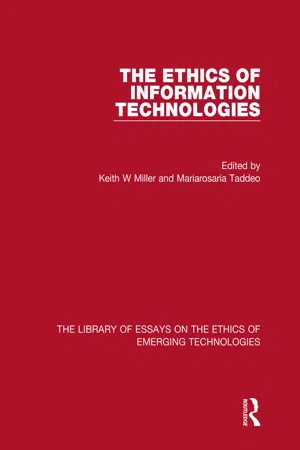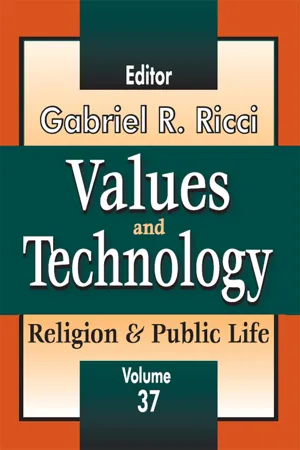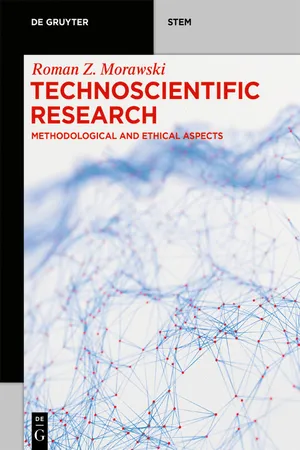Computer Science
Issues in Computer Science
Issues in Computer Science refer to the challenges and problems that arise in the development, implementation, and use of computer systems and software. These issues can range from technical problems such as software bugs and hardware failures to ethical and social concerns such as privacy, security, and the impact of technology on society.
Written by Perlego with AI-assistance
Related key terms
4 Key excerpts on "Issues in Computer Science"
- eBook - ePub
- Keith W Miller, Mariarosaria Taddeo(Authors)
- 2020(Publication Date)
- Routledge(Publisher)
Let us next examine some areas in which philosophers can help to clarify some existing and future conceptual confusions associated with moral issues in computing. Consider some of the confusion that currently exists with regard to exactly what is an ethical issue in computing. Birrer (1998) notes that it has become trendy to extend the term ‘computer ethics’ to apply to almost anything that for decades used to be referred to by terms such as ‘social issues in computing.’ Birrer goes on to point out that while many of the issues considered in this stretched sense of computer ethics may even be normative, they are not necessarily ethical in nature. Unfortunately, this important distinction is frequently glossed over, or in many cases overlooked altogether, in much of the computer ethics literature. 15 I have argued elsewhere (Tavani 1999b) that philosophers can play an important role in helping to sort out genuine ethical issues from those issues that are essentially sociological and descriptive in nature. If someone approaching the field of computer ethics for the first time were to examine much of the current literature that passes for ‘computer ethics’ and ‘Cyberethics,’ that person might get a very distorted picture of the field. For one thing, at least some of the books now being published with the expressions ‘computer ethics’ or ‘Cyberethics’ in their titles have little or nothing to do with ethics. For example, Willard’s The Cyberethics Reader (1997), despite its title, does not address ethical issues at all. That particular text focuses primarily on scenarios having to do with polite behavior or etiquette on the internet (i.e., what some referred to as ‘Netiquette’) - eBook - ePub
- Raymond E. E.Spier(Author)
- 2003(Publication Date)
- Routledge(Publisher)
Simon RogersonIntroduction
Advances in computer technology, coupled with the growing convergence of computing, telecommunications and mass media, present many opportunities and dangers to individuals, organizations and society as a whole. Computers can be shaped to do any activity that can be described in terms of inputs, transforming processes and outputs. It is the nearest thing to a universal tool (Moor 1985). Consequently, society and its organizations are becoming more dependent upon computer technology. There is an increasingly wider access to, and wider application of, this powerful resource. Those responsible for the development and application of computer technology are faced with decisions of increasing complexity which are accompanied by many ethical dilemmas. Moor (1985) and Maner (1996) explain that computer technology is a special and unique technology, hence the associated ethical issues warrant special attention. Indeed, Tucker (1991) points out that there is a need to understand the basic cultural, social, legal and ethical issues inherent in the discipline of computing. Furthermore, Gotterbarn (1992) suggests that professionals must be aware of their professional responsibilities, have available methods for resolving non-technical ethics questions and develop proactive skills to reduce the likelihood of ethical problems occurring.The nature of computer ethics
The field of computer ethics is evolving and has been defined in different ways. Walter Maner, who coined the term ‘computer ethics’ in the mid-1970s, defines computer ethics as representing a new field of applied professional ethics dealing with problems aggravated, transformed or created by computer technology. Deborah Johnson (1985) defines computer ethics as being the study of the way in which computers present new versions of standard moral problems and dilemmas, causing existing standard moral norms to be used in new and novel ways in an attempt to resolve these issues. James Moor (1985) defines computer ethics as the analysis of the nature and social impact of computer technology and the corresponding formulation and justification of policies for the ethical use of such technology. He suggests that it addresses policy vacuums and conceptual muddles brought about by the advancing technology. Finally, Terrell Ward Bynum (1997a) suggests that the overall goal of computer ethics is to integrate computing technology and human values in such a way that the technology advances and protects human values, rather than doing damage to them. - eBook - ePub
Values and Technology
Religion and Public Life
- Gabriel R. Ricci(Author)
- 2017(Publication Date)
- Routledge(Publisher)
However, it is always possible to find the right moment to attract students’ attention in the desired direction. Students should become familiar with the concept of computer ethics defined as “the analysis of the nature and social impact of computer technology and the corresponding formulation and justification” [20]. Computing courses which incorporate ethical issues and have been thought by the author are as follows: Introduction to Computer Applications, Computer Science I and II, Information Systems, Systems Analysis and Design, Database Systems, Database Systems Development and Applications, and Readings and Projects in Computing. Over the last few years, there has been a wonderful trend in publishing—an increase in the offering of computing of textbooks that contain ethics-related chapters in addition to specific computing topics. The courses mentioned above offer limited opportunities to teach ethical concepts and principles because of the wide range of topics that have to be covered in the given period of time. Today, most publishing companies offer a variety of textbooks which are appropriate for use in different disciplines, which include chapters discussing social and ethical issues, and which are related to multilateral computer aspects [ 1, 7, 11, 14 - 15, 23 - 24, 26 ]. Very often, the nature of the material taught in computing courses allows the instructor to shift the focus to ethical and moral issues related to software development. When students start designing and running their own computer programs, they are advised to consider whether the source code is understandable to other users. Students also need to think about the social impact of their software products. Initiating discussions about copyright concepts is also appropriate - No longer available |Learn more
Technoscientific Research
Methodological and Ethical Aspects
- Roman Z. Morawski(Author)
- 2019(Publication Date)
- De Gruyter(Publisher)
Both individual computers and computer networks (local, regional and global) can be used to commit common crimes, to violate privacy or to conduct espionage. They can cause damage to individuals or institutions if the software does not work as expected, because of a programmer’s error or his deliberate action; they can perform sophisticated logical and mathematical operations whose correctness cannot be checked by anybody. Computer ethics is to determine to what extent and in what situations we can trust computer systems, and what restrictions should be imposed on their use. IT means can be used for performing illegal operations, being serious ethical violations, which are, however, neither specific to the scientific community nor very frequent among its members; therefore, they will not be discussed here.The spectrum of IT-related ethical issues is systematically expanding with the development of IT, and it is increasingly more and more identified with the spectrum of ethical issue related to the infosphere. This is because the social impact of the IT development is becoming more and more recognised, and – consequently – ethical demands regarding the “ecological” management of the infosphere are more and more explicitly articulated. The relevant public debates focus on such issues as:- – the IT-induced evolution of the social context in which ethical problems, unrelated to technology, appear and are solved;
- – the increase in the objective scope and subjective sense of anonymity of operations performed on information;
- – the fuzzification of responsibility and increased sense of impunity for unethical processing of information.
The diversity of IT-related ethical issues and the inevitability of their appearance in everyday research practice are illustrated with the following series of examples. The common source of this diversity and inevitability is the extraordinary logical plasticity of computers933 and computer networks as tools for solving theoretical and practical problems in very diverse areas and in various social contexts.Example 19.1: Already in the 1980s, computers were used during the US presidential election for counting votes and forecasting the result of the election. Already at that time, the question was asked if it was acceptable that some voters knew the forecasts (disseminated by radio and television) before voting934 . This may seem an innocent exercise after scandalous involvement of the UK-based political consulting company Cambridge Analytica in the US presidential election in 2016. This company used in the election campaign personal information about ca. 50 million Facebook users, acquired by an external researcher who claimed to be collecting it for academic purposes. In May 2018, under pressure of public criticism, the company had to stop its operations and declare insolvency935
Index pages curate the most relevant extracts from our library of academic textbooks. They’ve been created using an in-house natural language model (NLM), each adding context and meaning to key research topics.



